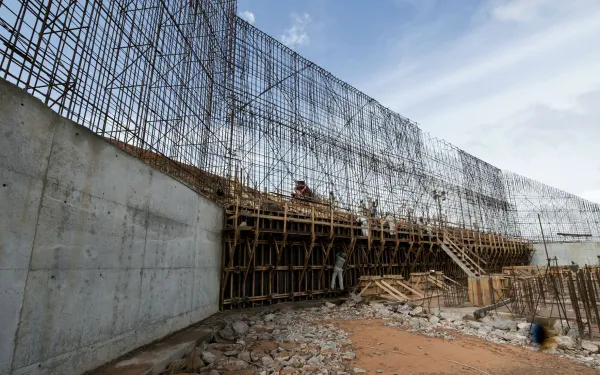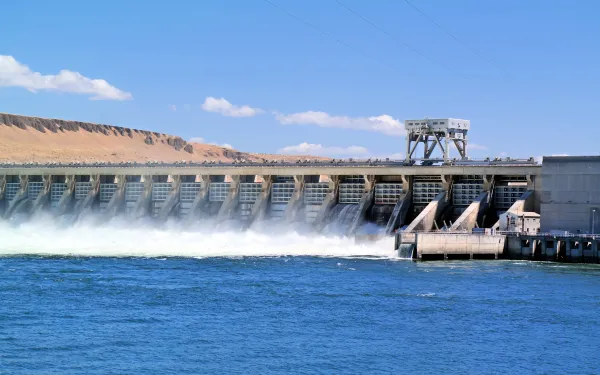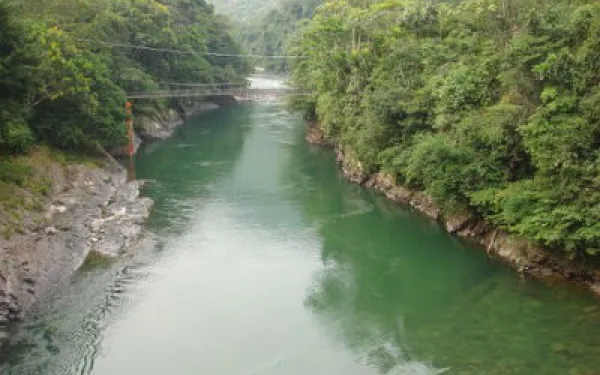57 CIVIL SOCIETY ORGANIZATIONS AND COALITIONS IN LATIN AMERICA INSIST THAT LARGE DAMS ARE NOT CLEAN ENERGY SOURCES AND WE ASK GOVERNMENTS, INTERNATIONAL ORGANIZATIONS AND FINANCIAL INSTITUTIONS TO IMPLEMENT REAL SOLUTIONS TO CLIMATE CHANGE
It is time to learn from the past and to implement alternatives appropriate to our time
According to the World Commission on Dams, by the year 2000, fifty thousand dams had already been built, disrupting more than 60% of Earth’s rivers.[1] In Latin America alone, 973 dams of all sizes are operating, and roughly 1,600 more are being built or planned—254 in the Amazon Basin.[2]
Scientific evidence reveals that large dams: emit greenhouse gases, including methane, especially in tropical regions,[3] aggravating climate change, and making adaptation more difficult; cost almost twice their initial budget, causing economic difficulties in the communities and countries where they are implemented;[4] take a long time to become operational, making them an inefficient solution to the urgent energy crisis that they are intended to tackle;[5] may cause great and irreparable environmental damage; and may cause human rights violations and impoverishment of communities if not implemented with appropriate safeguards.
Nevertheless, they continue to be promoted as clean energy sources to meet increasing energy demand.[6]
Why are dams not clean energy sources and why are alternatives needed?
1. Because they contribute to climate change and make adaptation more difficult
Construction and operation of large dams in tropical regions causes emission of CO2 and methane from the large amounts of flooded and retained organic matter in reservoirs. The greenhouse gas effect of methane is between 20 to 40 times more powerful than that of CO2.[7] Dams also destroy large areas of surrounding lands needed to build them.
Dams are not flexible enough to endure climate change. On the contrary, they are inefficient in droughts and unsafe in floods, which aggravates the risk of disasters. Moreover, they threaten communities’ entire hydrologic system, destroying key ecosystems and fisheries, thus compromising communities’ ability to adapt to climate change.
2. Because of the cost overruns, delays and economic damage that they entail
Data show that the final cost of the majority of dams that have been built is 96% greater than their initial budgets. This expense has been linked to the increase of public debt and to economic crisis in several countries.[8]
3. Because they take a long time to become operational, making them an inefficient solution to the urgent energy crisis that they are intended to tackle
Construction of large dams takes approximately 8.6 years, plus time to begin operating,[9] and they operate on average only 50 years.[10] Experts have documented that eight out of every ten dams exceed their initial construction-time estimates by more than 44%.[11] Dams are not an efficient solution to growing and urgent energy demand.
4. Because they may cause great and irreparable environmental damage
Large dams cause environmental damages to rivers, hydrologic basins and surrounding ecosystems, including: worsening water quality in rivers; degradation of aquatic ecosystems and disappearance of many riparian ecosystems; and serious harms to biodiversity, including the extinction of species.[12]
5. Because environmental damage may violate human rights and impoverish communities
The human rights of the people affected by large dams have been systematically unrecognized. Large dams have caused forced displacement;[13] health problems; loss of food sources and traditional ways of life; community impoverishment;[14] and criminalization of social protest. Additionally, permitting processes are generally flawed; permits are issued without comprehensive environmental or social impact assessments, and without adequate public participation and consultation.
TODAY there are cleaner, more efficient, less costly and faster alternatives to respond to energy demand. Therefore we DEMAND that Governments, international organizations and financial institutions immediately: Stop considering large dams as clean energy sources, given the proved negative impacts mentioned above. These impacts must be considered comprehensively. Incorporate in the planning stage for new dams: scientific evidence of greenhouse gas emissions, including methane produced by reservoirs; the instability that climate change causes in the hydrologic regime; lessons learned regarding costs and real implementation time of large dams; comprehensive evaluation of environmental and social impacts that will be caused; an integrated, realistic energy strategy through a Comprehensive Plan for Electric Sector Energy Resources; Make decisions that account for impacts on the environment, human rights and climate change. Implement real energy solutions that prove to be effective, with benefits that outweigh the harms they cause. Adopt inclusive and transparent decision-making processes, taking into account the whole spectrum of energy alternatives.
Abogadas y Abogados para la Justicia y los Derechos Humanos, A.C., México
Alianza de Comunidades y Usuarios en Defensa del Río Biobos-Nautla, México
Alianza para la Conservación y el Desarrollo (ACD), Panamá
Amazon Watch, Estados Unidos
Amazónicos por la Amazonía (AMPA), Perú
Amigos del Río San Rodrigo, México
Asamblea Veracruzana de Iniciativas y Defensa Ambiental (LAVIDA), México
Asociación Ambiente y Sociedad, Colombia
Asociación Amigos de los Parques Nacionales (AAPN), Argentina
Asociación Ceiba, Guatemala
Asociación de Ecología Social (AESO), Costa Rica
Asociación Interamericana para la Defensa del Ambiente (AIDA), Regional
Asociación Palmareña para la Recuperación del Ambiente (APRA), Costa Rica
Asociación Peruana para la Conservación de la Naturaleza, Perú
Asociación Pro Derechos Humanos (APRODEH), Perú
Asociación Proyectos Alternativos para Desarrollo Social (PROAL), Costa Rica
Bloque Verde, Costa Rica
Centro de Desarrollo Étnico (CEDET), Perú
Centro de Documentación en Derechos Humanos “Segundo Montes Mozo S.J.” (CSMM), Ecuador
Centro de Estudios para la Justicia Social "Tierra Digna", Colombia
Centro de Promoción y Defensa de Derechos Humanos Arequipa (CEPRODEH), Perú
Centro Humboldt, Nicaragua
Centro Mexicano de Derecho Ambiental, A.C. (CEMDA), México
Centro para la Sostenibilidad Ambiental de la Universidad Peruana Cayetano Heredia (CSA-UPCH), Perú
Colectivo Defensa Verde Naturaleza para Siempre, México
Comisión de Derechos Humanos de Ica, Perú
Comisión Ecuménica de Derechos Humanos (CEDHU), Ecuador
Comité por los Derechos en América Latina (CEDHAL), Canadá
Consejo de Ejidos y Comunidades Opositores a la Presa La Parota (CECOP), México
Coordinadora de Afectados por Embalses y Trasvases (COAGRET), España
Coordinadora Nacional de Derechos Humanos, Perú
Derechos Humanos y Medio Ambiente, Perú
Ecologia E Ação (ECOA), Brasil
Federación Ecologista de Costa Rica (FECON), Costa Rica
Finca Amalur, Costa Rica
Fiscalía del Medio Ambiente (FIMA), Chile
Foro Ciudadano de Participación por la Justicia y los Derechos Humanos (FORO), Argentina
Fórum Solidaridad Perú, Perú
Fundación Centro de Derechos Humanos y Ambiente (CEDHA), Argentina
Fundación Ecuménica para el Desarrollo y la Paz (FEDEPAZ), Perú
Fundación GaiaPacha, Bolivia
Fundación POPOL NA, Nicaragua
Fundar, México
Grupo Ecologista Cuña Pirú, Argentina
Instituto Madeira Vivo (IMV), Brasil
International Rivers, Estados Unidos
JASS, Asociadas por lo Justo, México
Justicia para la Naturaleza, Costa Rica
María Esperanza Alonso, especialista de Derecho Ambiental, Argentina
Movimiento Ciudadano frente al Cambio Climático (MOCICC), Perú
Oilwatch Mesoamérica, Costa Rica
Plataforma Interamericana de Derechos Humanos, Democracia y Desarrollo (PIDHDD Regional), Ecuador
Programa Chile Sustentable, Chile
Pueblos Unidos de la Cuenca Antigua por los Ríos Libres, México
Red Jurídica Amazónica (RAMA), Bolivia
Sociedad Peruana de Derecho Ambiental (SPDA), Perú
Unión Norte por la Vida, Costa Rica
For more information:
AIDA on dams: http://www.aida-americas.org/es/project/grandesrepresas
International Rivers: http://www.internationalrivers.org/
Report: Grandes Represas en América: ¿Peor el Remedio que la Enfermedad?
Blog: Desmantelando el mito de las represas, Grandes represas elefantes blancos, Hydropower Will Not Solve All Africa's Problems
[1] World Commission on Dams Report. http://www.internationalrivers.org/files/attached-files/world_commission_on_dams_final_report.pdf
[2] State of the World’s Rivers. http://www.internationalrivers.org/worldsrivers/
[3]2013 IPCC Supplement to the 2006 Guidelines for National GHG Inventories: Wetlands http://www.ipcc-nggip.iges.or.jp/public/wetlands/
[4]Ansar, Atif and Flyvbjerg, Bent and Budzier, Alexander and Lunn, Daniel, Should We Build More Large Dams? The Actual Costs of Hydropower Megaproject Development (March 10, 2014). Energy Policy, March 2014, pp.1-14.
[5] Ibid
[6] Directions for the World Bank Group’s Energy Sector.
http://www.worldbank.org/content/dam/Worldbank/document/SDN/energy-2013-0281-2.pdf
[7] Climate and Clear Air Coalition. Short-Lived Climate Pollutants. (2011).
http://www.unep.org/ccac/ShortLivedClimatePollutants/tabid/101650/Default.aspx.
[8] Ansar, A et al. Furthermore, the Brazilian Federal Court of Accountability carried out a study of the energy projects developed between 2005 and 2012, and it concluded that almost 80% of dams will not comply with their schedule. http://oglobo.globo.com/economia/tcu-constata-atrasos-nas-obras-de-energia-leiloadas-pelo-governo-de-2005-2012-13822128 (Spanish)
[9] Ansar, A., et al.
[10] Friends of the Earth, et al. Dam Removal Success Stories. (1999).
http://www.michigandnr.com/publications/pdfs/fishing/dams/SuccessStoriesReport.pdf http://www.teachengineering.org/view_lesson.php?url=collection/cub_/lessons/cub_dams/cub_dams_lesson08.xml
[11] Ansar, A., et al.
[12] AIDA. Grandes Represas en América: ¿Peor el remedio que la enfermedad?
http://www.aida-americas.org/sites/default/files/InformeAIDA_GrandesRepreseas_BajaRes_1.pdf (Spanish)
[13] According to the World Commission on Dams, between 40 and 80 million people have been displaced due to big dams—approximately one out of every 100 people alive today.
[14] Thayer Scudder, California Institute of Technology, promoted construction of dams for 58 years, believing that they were an option for the relief of poverty. He publicly changed his mind when he was 84 years old, declaring that they are not worth their cost and that many of the dams currently under construction will have disastrous consequences. New York Times. http://www.nytimes.com/2014/08/24/opinion/sunday/large-dams-just-arent-worth-the-cost.html?emc=eta1&_r=3
Read more 



